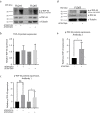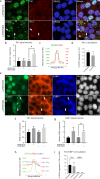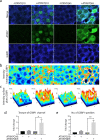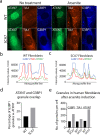Key Modulators of the Stress Granule Response TIA1, TDP-43, and G3BP1 Are Altered by Polyglutamine-Expanded ATXN7
- PMID: 35689166
- PMCID: PMC9363381
- DOI: 10.1007/s12035-022-02888-2
Key Modulators of the Stress Granule Response TIA1, TDP-43, and G3BP1 Are Altered by Polyglutamine-Expanded ATXN7
Abstract
Spinocerebellar ataxia type 7 (SCA7) and other polyglutamine (polyQ) diseases are caused by expansions of polyQ repeats in disease-specific proteins. Aggregation of the polyQ proteins resulting in various forms of cellular stress, that could induce the stress granule (SG) response, is believed to be a common pathological mechanism in these disorders. SGs can contribute to cell survival but have also been suggested to exacerbate disease pathology by seeding protein aggregation. In this study, we show that two SG-related proteins, TDP-43 and TIA1, are sequestered into the aggregates formed by polyQ-expanded ATXN7 in SCA7 cells. Interestingly, mutant ATXN7 also localises to induced SGs, and this association altered the shape of the SGs. In spite of this, neither the ability to induce nor to disassemble SGs, in response to arsenite stress induction or relief, was affected in SCA7 cells. Moreover, we could not observe any change in the number of ATXN7 aggregates per cell following SG induction, although a small, non-significant, increase in total aggregated ATXN7 material could be detected using filter trap. However, mutant ATXN7 expression in itself increased the speckling of the SG-nucleating protein G3BP1 and the SG response. Taken together, our results indicate that the SG response is induced, and although some key modulators of SGs show altered behaviour, the dynamics of SGs appear normal in the presence of mutant ATXN7.
Keywords: G3BP1; Neurodegeneration; Spinocerebellar ataxia type 7; Stress granules; TDP-43; TIA1.
© 2022. The Author(s).
Conflict of interest statement
The authors declare no competing interests.
Figures








Similar articles
-
Zika Virus Subverts Stress Granules To Promote and Restrict Viral Gene Expression.J Virol. 2019 May 29;93(12):e00520-19. doi: 10.1128/JVI.00520-19. Print 2019 Jun 15. J Virol. 2019. PMID: 30944179 Free PMC article.
-
Typical Stress Granule Proteins Interact with the 3' Untranslated Region of Enterovirus D68 To Inhibit Viral Replication.J Virol. 2020 Mar 17;94(7):e02041-19. doi: 10.1128/JVI.02041-19. Print 2020 Mar 17. J Virol. 2020. PMID: 31941779 Free PMC article.
-
The stress granule protein G3BP1 alleviates spinocerebellar ataxia-associated deficits.Brain. 2023 Jun 1;146(6):2346-2363. doi: 10.1093/brain/awac473. Brain. 2023. PMID: 36511898 Free PMC article.
-
Two Birds With One Stone: RNA Virus Strategies to Manipulate G3BP1 and Other Stress Granule Components.Wiley Interdiscip Rev RNA. 2025 Mar-Apr;16(2):e70005. doi: 10.1002/wrna.70005. Wiley Interdiscip Rev RNA. 2025. PMID: 40170442 Free PMC article. Review.
-
Application of stress granule core element G3BP1 in various diseases: A review.Int J Biol Macromol. 2024 Dec;282(Pt 5):137254. doi: 10.1016/j.ijbiomac.2024.137254. Epub 2024 Nov 6. Int J Biol Macromol. 2024. PMID: 39515684 Review.
Cited by
-
Implications of TDP-43 in non-neuronal systems.Cell Commun Signal. 2023 Nov 23;21(1):338. doi: 10.1186/s12964-023-01336-5. Cell Commun Signal. 2023. PMID: 37996849 Free PMC article. Review.
-
Intracellular and intercellular transport of RNA organelles in CXG repeat disorders: The strength of weak ties.Front Mol Biosci. 2022 Dec 16;9:1000932. doi: 10.3389/fmolb.2022.1000932. eCollection 2022. Front Mol Biosci. 2022. PMID: 36589236 Free PMC article. Review.
References
-
- Palhan VB, Chen S, Peng G-H, Tjernberg A, Gamper AM, Fan Y, Chait BT, La Spada AR, Roeder RG. Polyglutamine-expanded ataxin-7 inhibits STAGA histone acetyltransferase activity to produce retinal degeneration. Proc Natl Acad Sci USA. 2005;102(24):8472–8477. doi: 10.1073/pnas.0503505102. - DOI - PMC - PubMed
MeSH terms
Substances
Grants and funding
LinkOut - more resources
Full Text Sources
Research Materials
Miscellaneous

